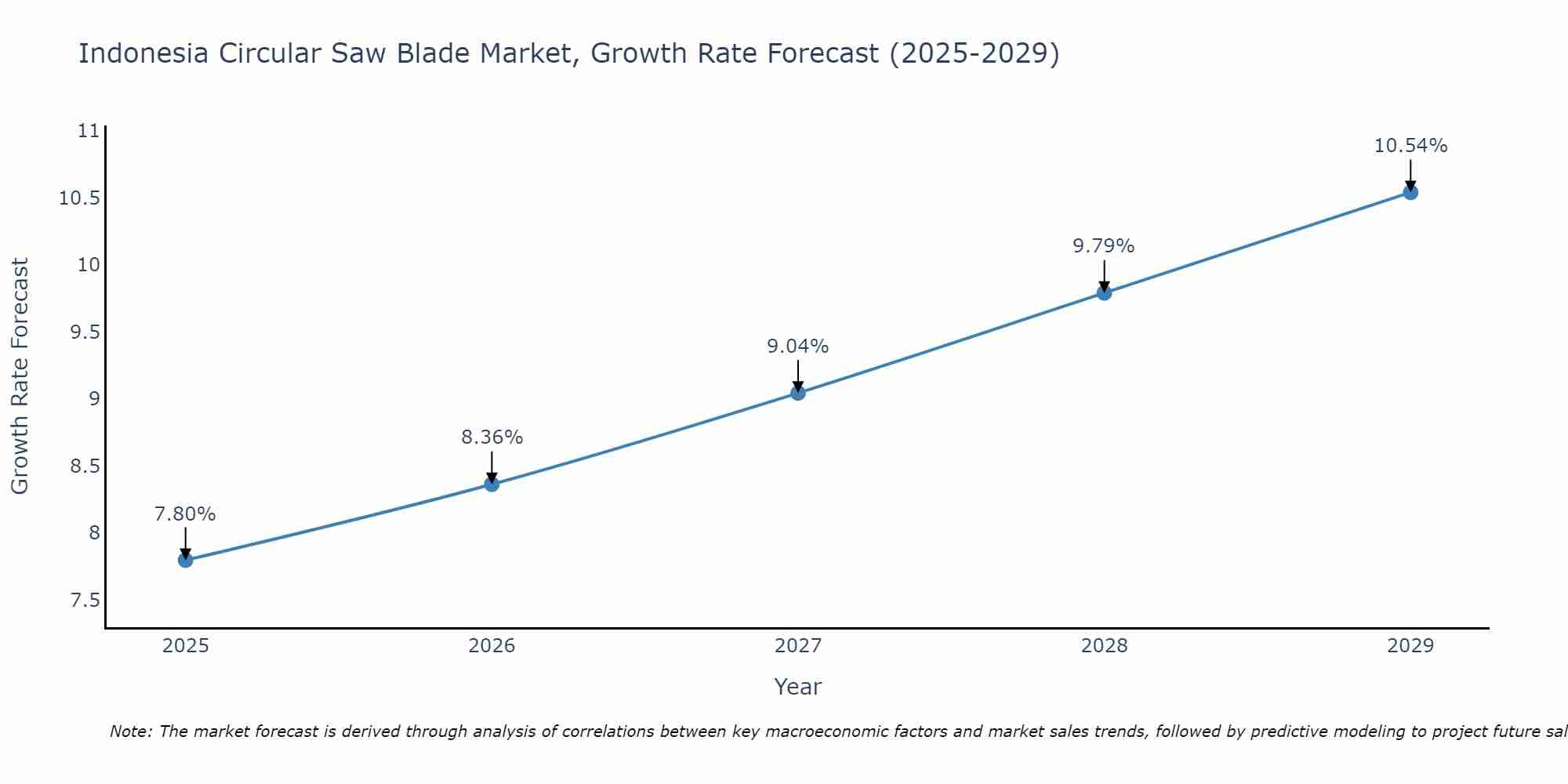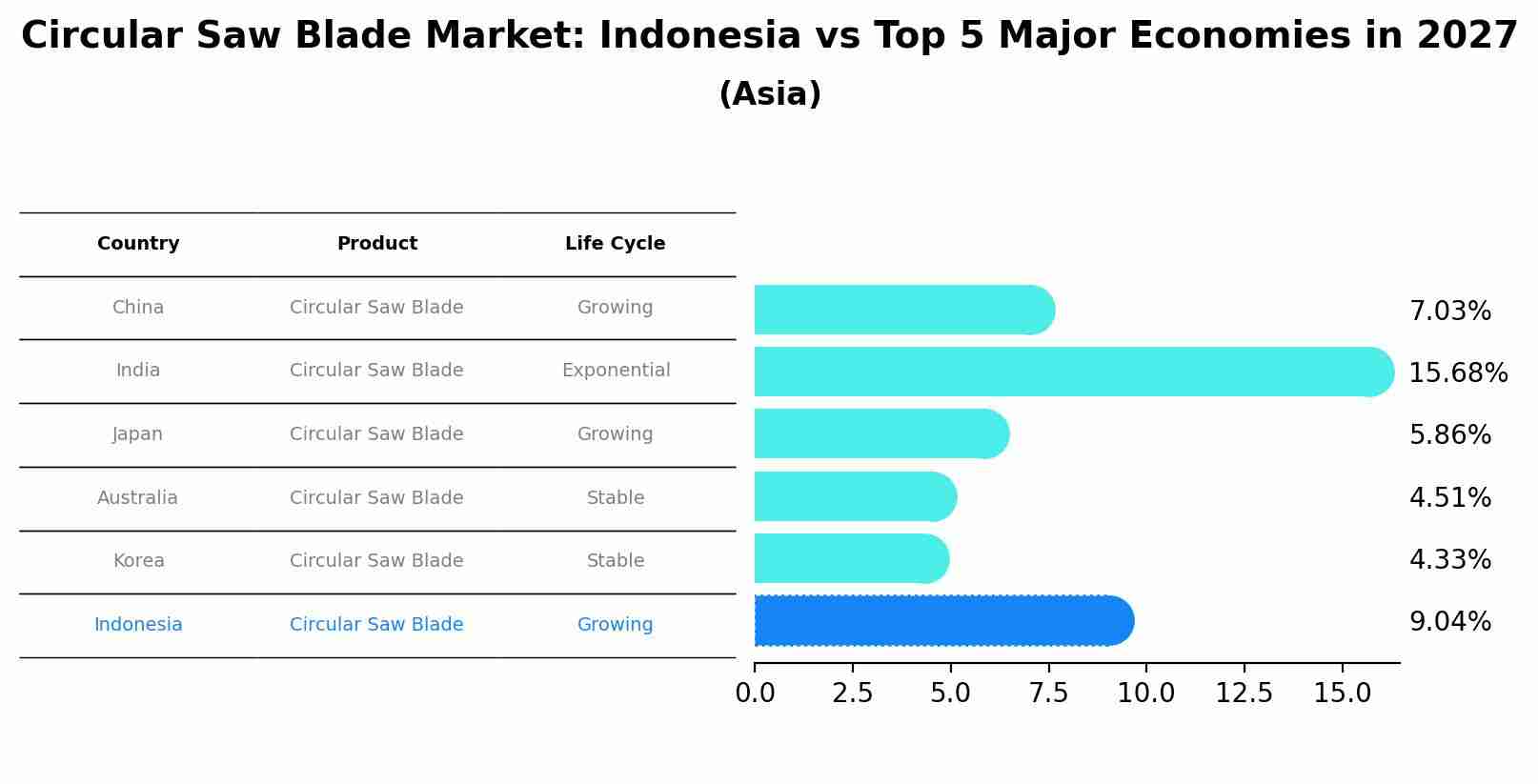Indonesia Circular Saw Blade Market (2024-2030) | Industry, Size, Analysis, Growth, Companies, Outlook, Forecast, Share, Revenue, Trends & Value
| Product Code: ETC053228 | Publication Date: Jul 2023 | Updated Date: Apr 2025 | Product Type: Report | |
| Publisher: 6Wresearch | No. of Pages: 70 | No. of Figures: 35 | No. of Tables: 5 | |
Indonesia Circular Saw Blade Market Size Growth Rate
The Indonesia Circular Saw Blade Market is poised for steady growth rate improvements from 2025 to 2029. The growth rate starts at 7.80% in 2025 and reaches 10.54% by 2029.

Circular Saw Blade Market: Indonesia vs Top 5 Major Economies in 2027 (Asia)
In the Asia region, the Circular Saw Blade market in Indonesia is projected to expand at a growing growth rate of 9.04% by 2027. The largest economy is China, followed by India, Japan, Australia and South Korea.

Indonesia Circular Saw Blade Market Synopsis
The Indonesia circular saw blade market is expected to grow at a CAGR of 6.8% during theperiod 2020-2026. The growing demand for woodworking tools and machines in Indonesia is driving theof the circular saw blade market in this country. Furthermore support from the government through various initiatives such as tax exemptions are further supporting marketin this region. Additionally with an increasing number of construction activities across the country due to rapid urbanization and industrialization will create opportunities for manufacturers operating within this sector.
Key Factors Driving the Market
There has been a significant increase in demand for woodworking tools and machines over recent years due to their convenience of use and cost savings associated with them when compared traditional carpentry methods or manual labor costs associated with it. This has led to an increased adoption among end users leading to higher sales volumes which consequently results into rising s being generated by players operating within this segment. The Indonesia government has taken several steps towards improving its manufacturingby providing incentives such as tax breaks on imported equipment used primarily by small scale businesses within these sectors thus encouraging investment inflow into these segments resulting expanding capacity utilization rates among local players present here thus resulting into improved profitability margins for them respectively . Additionally they have also opened up more avenues leading towards greater foreign direct investments (FDI) inflows that will help mainly larger multinationals gain better access presence in Indonesia markets driving overallstreams generated from here even further.
Challenges Facing the Market
Despite having supportive government policies there still remains certain challenges faced by local players looking forward to investing heavily into automation technologies owing mainly due high capital costs associated with procuring the same making it difficult especially for smaller firms present here who lack the necessary resources required to make such purchases thereby limiting potential returns obtained from same subsequently cutting down profits earned significantly. Another major challenge lies in difficulty finding skilled manpower availability operate machinery-installed factories which could hamper operations if not addressed adequately time before leads higher levels of waste and inefficient production cycles eventually affecting bottom-line s and negatively impacting the total annual turnover of respectiveaccordingly.
Key Market Players
Some key players operating in Indonesia circular saw blades include Bosch GmbHDeWalt Industrial Tool Co. Makita CorporationMetabo
Key Highlights of the Report:
- Indonesia Circular Saw Blade Market Outlook
- Market Size of Indonesia Circular Saw Blade Market, 2023
- Forecast of Indonesia Circular Saw Blade Market, 2030
- Historical Data and Forecast of Indonesia Circular Saw Blade Revenues & Volume for the Period 2020-2030
- Indonesia Circular Saw Blade Market Trend Evolution
- Indonesia Circular Saw Blade Market Drivers and Challenges
- Indonesia Circular Saw Blade Price Trends
- Indonesia Circular Saw Blade Porter's Five Forces
- Indonesia Circular Saw Blade Industry Life Cycle
- Historical Data and Forecast of Indonesia Circular Saw Blade Market Revenues & Volume By Product Types for the Period 2020-2030
- Historical Data and Forecast of Indonesia Circular Saw Blade Market Revenues & Volume By Carbide Saw Blades for the Period 2020-2030
- Historical Data and Forecast of Indonesia Circular Saw Blade Market Revenues & Volume By Diamond Saw Blades for the Period 2020-2030
- Historical Data and Forecast of Indonesia Circular Saw Blade Market Revenues & Volume By Others for the Period 2020-2030
- Historical Data and Forecast of Indonesia Circular Saw Blade Market Revenues & Volume By Applications for the Period 2020-2030
- Historical Data and Forecast of Indonesia Circular Saw Blade Market Revenues & Volume By Wood and Wood-based Materials Cutting for the Period 2020-2030
- Historical Data and Forecast of Indonesia Circular Saw Blade Market Revenues & Volume By Metal Materials Cutting for the Period 2020-2030
- Historical Data and Forecast of Indonesia Circular Saw Blade Market Revenues & Volume By Stone Cutting for the Period 2020-2030
- Historical Data and Forecast of Indonesia Circular Saw Blade Market Revenues & Volume By Others for the Period 2020-2030
- Indonesia Circular Saw Blade Import Export Trade Statistics
- Market Opportunity Assessment By Product Types
- Market Opportunity Assessment By Applications
- Indonesia Circular Saw Blade Top Companies Market Share
- Indonesia Circular Saw Blade Competitive Benchmarking By Technical and Operational Parameters
- Indonesia Circular Saw Blade Company Profiles
- Indonesia Circular Saw Blade Key Strategic Recommendations
Frequently Asked Questions About the Market Study (FAQs):
1 Executive Summary |
2 Introduction |
2.1 Key Highlights of the Report |
2.2 Report Description |
2.3 Market Scope & Segmentation |
2.4 Research Methodology |
2.5 Assumptions |
3 Indonesia Circular Saw Blade Market Overview |
3.1 Indonesia Country Macro Economic Indicators |
3.2 Indonesia Circular Saw Blade Market Revenues & Volume, 2020 & 2030F |
3.3 Indonesia Circular Saw Blade Market - Industry Life Cycle |
3.4 Indonesia Circular Saw Blade Market - Porter's Five Forces |
3.5 Indonesia Circular Saw Blade Market Revenues & Volume Share, By Product Types, 2020 & 2030F |
3.6 Indonesia Circular Saw Blade Market Revenues & Volume Share, By Applications, 2020 & 2030F |
4 Indonesia Circular Saw Blade Market Dynamics |
4.1 Impact Analysis |
4.2 Market Drivers |
4.3 Market Restraints |
5 Indonesia Circular Saw Blade Market Trends |
6 Indonesia Circular Saw Blade Market, By Types |
6.1 Indonesia Circular Saw Blade Market, By Product Types |
6.1.1 Overview and Analysis |
6.1.2 Indonesia Circular Saw Blade Market Revenues & Volume, By Product Types, 2020-2030F |
6.1.3 Indonesia Circular Saw Blade Market Revenues & Volume, By Carbide Saw Blades, 2020-2030F |
6.1.4 Indonesia Circular Saw Blade Market Revenues & Volume, By Diamond Saw Blades, 2020-2030F |
6.1.5 Indonesia Circular Saw Blade Market Revenues & Volume, By Others, 2020-2030F |
6.2 Indonesia Circular Saw Blade Market, By Applications |
6.2.1 Overview and Analysis |
6.2.2 Indonesia Circular Saw Blade Market Revenues & Volume, By Wood and Wood-based Materials Cutting, 2020-2030F |
6.2.3 Indonesia Circular Saw Blade Market Revenues & Volume, By Metal Materials Cutting, 2020-2030F |
6.2.4 Indonesia Circular Saw Blade Market Revenues & Volume, By Stone Cutting, 2020-2030F |
6.2.5 Indonesia Circular Saw Blade Market Revenues & Volume, By Others, 2020-2030F |
7 Indonesia Circular Saw Blade Market Import-Export Trade Statistics |
7.1 Indonesia Circular Saw Blade Market Export to Major Countries |
7.2 Indonesia Circular Saw Blade Market Imports from Major Countries |
8 Indonesia Circular Saw Blade Market Key Performance Indicators |
9 Indonesia Circular Saw Blade Market - Opportunity Assessment |
9.1 Indonesia Circular Saw Blade Market Opportunity Assessment, By Product Types, 2020 & 2030F |
9.2 Indonesia Circular Saw Blade Market Opportunity Assessment, By Applications, 2020 & 2030F |
10 Indonesia Circular Saw Blade Market - Competitive Landscape |
10.1 Indonesia Circular Saw Blade Market Revenue Share, By Companies, 2023 |
10.2 Indonesia Circular Saw Blade Market Competitive Benchmarking, By Operating and Technical Parameters |
11 Company Profiles |
12 Recommendations |
13 Disclaimer |
- Single User License$ 1,995
- Department License$ 2,400
- Site License$ 3,120
- Global License$ 3,795
Search
Related Reports
- Portugal Electronic Document Management Market (2025-2031) | Strategy, Consumer Insights, Analysis, Investment Trends, Opportunities, Growth, Size, Share, Industry, Revenue, Segments, Value, Segmentation, Supply, Forecast, Restraints, Outlook, Competition, Drivers, Trends, Demand, Pricing Analysis, Competitive, Strategic Insights, Companies, Challenges
- France Electronic Document Management Market (2025-2031) | Strategy, Consumer Insights, Analysis, Investment Trends, Opportunities, Growth, Size, Share, Industry, Revenue, Segments, Value, Segmentation, Supply, Forecast, Restraints, Outlook, Competition, Drivers, Trends, Demand, Pricing Analysis, Competitive, Strategic Insights, Companies, Challenges
- Portugal Occupational Health & Safety Services Market (2025-2031) | Strategy, Consumer Insights, Analysis, Investment Trends, Opportunities, Growth, Size, Share, Industry, Revenue, Segments, Value, Segmentation, Supply, Forecast, Restraints, Outlook, Competition, Drivers, Trends, Demand, Pricing Analysis, Competitive, Strategic Insights, Companies, Challenges
- Netherlands Occupational Health and Safety Services Market (2025-2031) | Strategy, Consumer Insights, Analysis, Investment Trends, Opportunities, Growth, Size, Share, Industry, Revenue, Segments, Value, Segmentation, Supply, Forecast, Restraints, Outlook, Competition, Drivers, Trends, Demand, Pricing Analysis, Competitive, Strategic Insights, Companies, Challenges
- Belgium and Luxembourg Facility Management Market (2025-2031) | Strategy, Consumer Insights, Analysis, Investment Trends, Opportunities, Growth, Size, Share, Industry, Revenue, Segments, Value, Segmentation, Supply, Forecast, Restraints, Outlook, Competition, Drivers, Trends, Demand, Pricing Analysis, Competitive, Strategic Insights, Companies, Challenges
- Russia Women Intimate Apparel Market (2025-2031) | Strategy, Consumer Insights, Analysis, Investment Trends, Opportunities, Growth, Size, Share, Industry, Revenue, Segments, Value, Segmentation, Supply, Forecast, Restraints, Outlook, Competition, Drivers, Trends, Demand, Pricing Analysis, Competitive, Strategic Insights, Companies, Challenges
- Africa Chocolate Market (2025-2031) | Size, Share, Trends, Growth, Revenue, Analysis, Forecast, industry & Outlook
- Global Hydroxychloroquine And Chloroquine Market (2025-2031) | Industry, Trends, Size, Outlook, Growth, Value, Companies, Revenue, Analysis, Share, Forecast
- Saudi Arabia Plant Maintenance Market (2025-2031) | Industry, Size, Growth, Revenue, Value, Companies, Forecast, Analysis, Share & Trends
- Taiwan Electric Truck Market (2025-2031) | Outlook, Industry, Revenue, Size, Forecast, Growth, Analysis, Share, Companies, Value & Trends
Industry Events and Analyst Meet
Our Clients
Whitepaper
- Middle East & Africa Commercial Security Market Click here to view more.
- Middle East & Africa Fire Safety Systems & Equipment Market Click here to view more.
- GCC Drone Market Click here to view more.
- Middle East Lighting Fixture Market Click here to view more.
- GCC Physical & Perimeter Security Market Click here to view more.
6WResearch In News
- Doha a strategic location for EV manufacturing hub: IPA Qatar
- Demand for luxury TVs surging in the GCC, says Samsung
- Empowering Growth: The Thriving Journey of Bangladesh’s Cable Industry
- Demand for luxury TVs surging in the GCC, says Samsung
- Video call with a traditional healer? Once unthinkable, it’s now common in South Africa
- Intelligent Buildings To Smooth GCC’s Path To Net Zero













